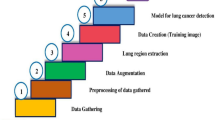Abstract
Lung Cancer Detection using improvised Grad-Cam++ with 3D CNN with class activation for classification of lung nodules and early detection of lung cancer. So, the question is how can deep learning methods we use to solve high-impact medical problems such as lung cancer detection. And more specifically how can we use 3D convolution neural networks in this specific application for detection of lung cancer. No matter how good your deep learning model is if it’s not interpretable to people in the domain it’s really hard for them to adopt. So, all models recently they’ve been known to have very good accuracies especially deep learning models specifically but if the domain expert can’t trust the model then it doesn’t mean. Gradient weighted class activation mapping or Grad Cam++ to visualize the models decision-making an increased radiologist trust and improve adoption in the field. We have achieved an overall accuracy of 94% on LUNA 16 dataset which was better compared with remaining architectures, as per the literature study we done.
Access this chapter
Tax calculation will be finalised at checkout
Purchases are for personal use only
Similar content being viewed by others
References
P. Afshar, A. Mohammadi, K.N. Plataniotis, A. Oikonomou, H. Benali, From handcrafted to deep-learning-based cancer radiomics: Challenges and opportunities. IEEE Signal Process. Mag. 36(4), 132–160 (2019). https://doi.org/10.1109/MSP.2019.2900993
S. Makaju, P.W.C. Prasad, A. Alsadoon, A.K. Singh, A. Elchouemi, Lung cancer detection using CT scan images. Procedia Comput. Sci. 125(2009), 107–114 (2018). https://doi.org/10.1016/j.procs.2017.12.016
A. Chattopadhyay, A. Sarkar, P. Howlader, V.N. Balasubramanian, Grad-CAM++: Generalized gradient-based visual explanations for deep convolutional networks, in Proceedings—2018 IEEE Winter Conference on Applications of Computer Vision, WACV 2018 (2018), pp. 839–847. https://doi.org/10.1109/WACV.2018.00097
H. Polat, H.D. Mehr, Classification of pulmonary CT images by using hybrid 3D-deep convolutional neural network architecture. Appl. Sci. (Switzerland) 9(5) (2019). https://doi.org/10.3390/app9050940
P. Satti, N. Sharma, B. Garg, Min-max average pooling based filter for impulse noise removal. IEEE Signal Process. Lett. 27, 1475–1479 (2020). https://doi.org/10.1109/LSP.2020.3016868
D. Ardila, A.P. Kiraly, S. Bharadwaj, B. Choi, J.J. Reicher, L. Peng, D. Tse, M. Etemadi, W. Ye, G. Corrado, D.P. Naidich, S. Shetty, End-to-end lung cancer screening with three-dimensional deep learning on low-dose chest computed tomography. Nat. Med. 25(6), 954–961 (2019). https://doi.org/10.1038/s41591-019-0447-x
Ö. Günaydin, M. Günay, Ö. Şengel, Comparison of lung cancer detection algorithms. 2019 Scientific Meeting on Electrical-Electronics and Biomedical Engineering and Computer Science, EBBT 2019 (2019). https://doi.org/10.1109/EBBT.2019.8741826
T. Kadir, F. Gleeson, Lung cancer prediction using machine learning and advanced imaging techniques. Transl. Lung Cancer Res. 7(3), 304–312 (2018). https://doi.org/10.21037/tlcr.2018.05.15
M. Kroenke, K. Hirata, A. Gafita, S. Watanabe, S. Okamoto, K. Magota, T. Shiga, Y. Kuge, N. Tamaki, Voxel based comparison and texture analysis of 18 F-FDG and 18 F-FMISO PET of patients with head-and-neck cancer. PLoS ONE 14(2) (2019). https://doi.org/10.1371/journal.pone.0213111
W.W. Labaki, T. Gu, S. Murray, C.R. Hatt, C.J. Galbán, B.D. Ross, C.H. Martinez, J.L. Curtis, E.A. Hoffman, E. Pompe, D.A. Lynch, E.A. Kazerooni, F.J. Martinez, M.L.K. Han, Voxel-wise longitudinal parametric response mapping analysis of chest computed tomography in smokers. Acad. Radiol. 26(2), 217–223 (2019). https://doi.org/10.1016/j.acra.2018.05.024
lecun-bengio-95a. (n.d.).
D. Li, B.M. Vilmun, J.F. Carlsen, E. Albrecht-Beste, C.A. Lauridsen, M.B. Nielsen, K.L. Hansen, The performance of deep learning algorithms on automatic pulmonary nodule detection and classification tested on different datasets that are not derived from LIDC-IDRI: a systematic review, in Diagnostics, vol. 9, Issue 4. MDPI AG (2019). https://doi.org/10.3390/diagnostics9040207
A. Masood, B. Sheng, P. Li, X. Hou, X. Wei, J. Qin, D. Feng, Computer-assisted decision support system in pulmonary cancer detection and stage classification on CT images. J. Biomed. Inform. 79, 117–128 (2018). https://doi.org/10.1016/j.jbi.2018.01.005
P. Naresh, R. Shettar, et al., Early detection of lung cancer using neural network techniques. J. Eng. Res. Appl. 4(4), 2248–962278 (2014). www.ijera.com
N. Nasrullah, J. Sang, M.S. Alam, M. Mateen, B. Cai, H. Hu, Automated lung nodule detection and classification using deep learning combined with multiple strategies. Sensors (Switzerland) 19(17) (2019).https://doi.org/10.3390/s19173722
K. Roy, S.S. Chaudhury, M. Burman, A. Ganguly, C. Dutta, S. Banik, R. Banik, A comparative study of lung cancer detection using supervised neural network. 2019 International Conference on Opto-Electronics and Applied Optics, Optronix 2019, pp. 1–5 (2019). https://doi.org/10.1109/OPTRONIX.2019.8862326
R.R. Selvaraju, M. Cogswell, A. Das, R. Vedantam, D. Parikh, D. Batra, Grad-CAM: visual explanations from deep networks via gradient-based localization. Int. J. Comput. Vision 128(2), 336–359 (2020). https://doi.org/10.1007/s11263-019-01228-7
S. Shen, S.X. Han, D.R. Aberle, A.A. Bui, W. Hsu, An interpretable deep hierarchical semantic convolutional neural network for lung nodule malignancy classification. Expert Syst. Appl. 128, 84–95 (2019). https://doi.org/10.1016/j.eswa.2019.01.048
D.J. Stewart (ed.), Lung Cancer Prevention, Management, and Emerging Therapies (n.d.). www.springer.com/series/7631
P. Tripathi, S. Tyagi, M. Nath, A comparative analysis of segmentation techniques for lung cancer detection. Pattern Recogn. Image Anal. 29(1), 167–173 (2019). https://doi.org/10.1134/S105466181901019X
X. Zhao, S. Qi, B. Zhang, H. Ma, W. Qian, Y. Yao, J. Sun, Deep CNN models for pulmonary nodule classification: model modification, model integration, and transfer learning. J. X-Ray Sci. Technol. 27(4), 615–629 (2019). https://doi.org/10.3233/XST-180490
W. Zuo, F. Zhou, Z. Li, L. Wang, Multi-resolution cnn and knowledge transfer for candidate classification in lung nodule detection. IEEE Access 7, 32510–32521 (2019). https://doi.org/10.1109/ACCESS.2019.2903587
Acknowledgements
This work was supported by Dr. Debnath Bhattacharyya, Professor, Department of Computer Science and Engineering, Koneru Lakshmaiah Education Foundation, K.L. University, Guntur 522502, Andhra-Pradesh, India.
Author information
Authors and Affiliations
Corresponding author
Editor information
Editors and Affiliations
Rights and permissions
Copyright information
© 2021 The Author(s), under exclusive license to Springer Nature Singapore Pte Ltd.
About this paper
Cite this paper
Joshua, E.S.N., Chakkravarthy, M., Bhattacharyya, D. (2021). Lung Cancer Detection Using Improvised Grad-Cam++ With 3D CNN Class Activation. In: Saha, S.K., Pang, P.S., Bhattacharyya, D. (eds) Smart Technologies in Data Science and Communication. Lecture Notes in Networks and Systems, vol 210. Springer, Singapore. https://doi.org/10.1007/978-981-16-1773-7_5
Download citation
DOI: https://doi.org/10.1007/978-981-16-1773-7_5
Published:
Publisher Name: Springer, Singapore
Print ISBN: 978-981-16-1772-0
Online ISBN: 978-981-16-1773-7
eBook Packages: Intelligent Technologies and RoboticsIntelligent Technologies and Robotics (R0)




